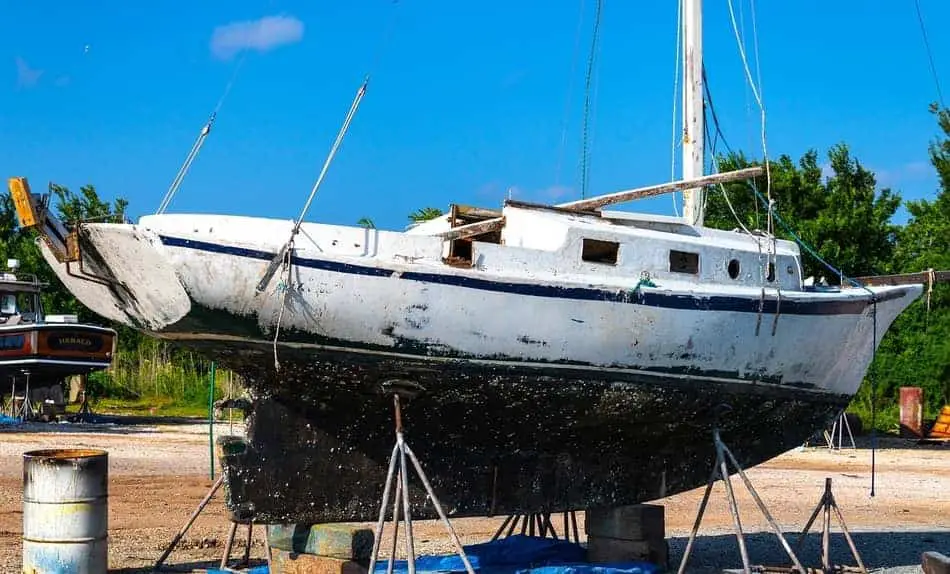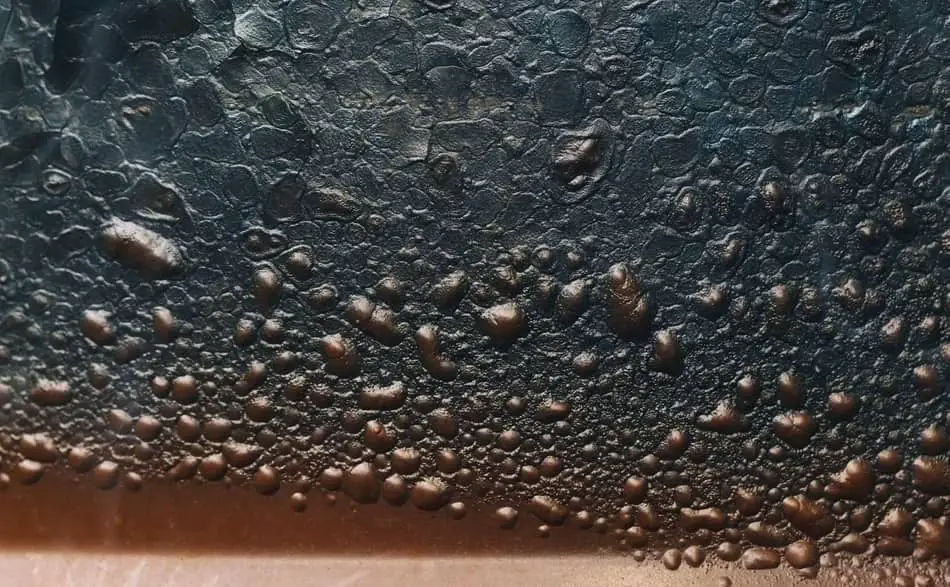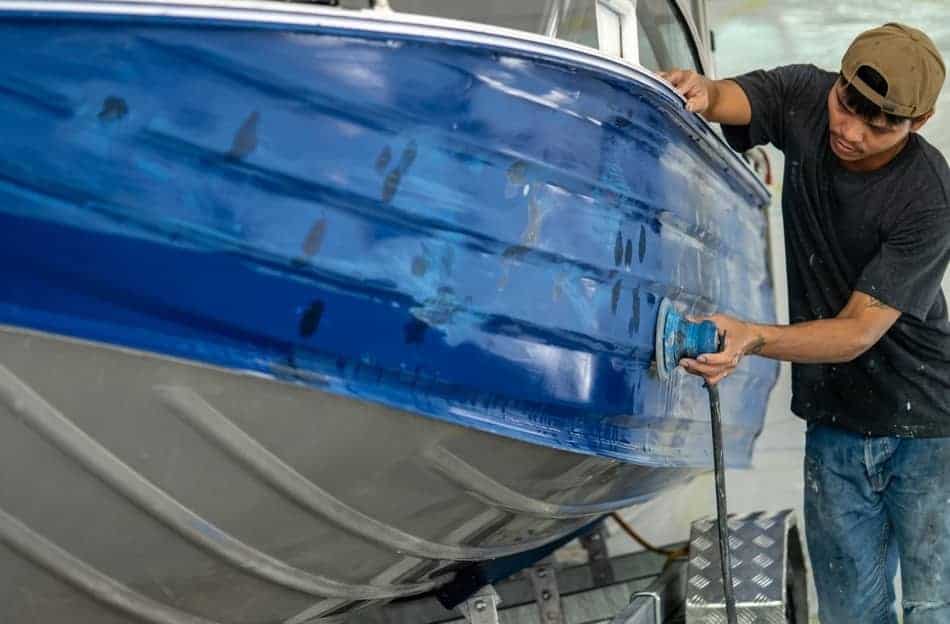Nowadays, blisters on the boat hull are becoming more common as part of the boat’s life. Blisters are present in just about every fiberglass hull and continuing, in the same way as corrosion in steel boats. So, when they form on your boat’s hull, do you need to bother about them? Are boat blisters a problem?
Blisters on a boat are mostly an aesthetic problem in the early stages, nothing more or less. Unless you found many or have been there for a long time, they are not a problem, and you don’t have to worry about them. They rarely cause structural problems to the boat unless they are unusually severe.
Treating them very often (in every quarter or for 6 months) will result in damaging your pocket first and the boat due to constant repairs (laminations, repainting, etc.). So, treating them on an annual or biannual basis is highly recommended as basic maintenance.
The time to worry about the blisters is when you are getting blisters about foot or palm-size (10 inches or more), which are hard and cannot be punctured sometimes without tools. This also indicates that delamination is occurring within the lay-up itself, which could result in structural damage to your boat.
Unlike in the past, nowadays, blisters are present in just about every fiberglass or GRP (glass reinforcement plastic) hull and continuing in the same way as corrosion in steel boats. Look below for blister causes on the boat hulls to know why they are often seen these days.
If a hull is 5 years old or more and has no blisters, there’s about a 95% probability that it never will. If it has even one blister, the chances are very high that it will continue. The more blisters it has in inverse proportion to its age, the more likely the problem will worsen at a progressive rate.
David Pascoe
If you saw one blister on your hull, Yes, it will continue to get worst. Once water penetrates the gel coat, it won’t stop unless appropriate measures are taken. Any boat which sits in the water for months need bottom paint (Barrier coat and then antifouling paint). Look below for blister prevention on the boat hull.
Finally, unless if you see many blisters on your boat or have been there for a long time or if there are bigger in size, you need not worry about them; just concentrate on boating or fishing. Spotting a few of them is fine, and you don’t have to fix them immediately.
Related post – What are barnacles on boats? Check this article to know the effects of barnacles on boats and how to prevent them. Barnacles are similar to blisters; both damages the boat.

What are the effects of blisters on a boat hull?
Though blisters are common in most fiberglass boats, does that mean we can leave them like that without any worries? Do blisters hurt the boat? Here are the effects of blisters on boats.
Blisters on a boat will not affect much, but if there are many/big blisters on the hull or have been there for a long time, it could affect the boat’s structural strength. It also diminishes the boat’s appealing look, and resale value will go down (mostly, it will cover those blister repair bills).
Blisters on a boat are NOT going to do major damages (structural damage) and don’t necessarily have to be fixed immediately. They are more of an aesthetic issue rather than functional. They are tedious to repair but nothing that a few weekends of work couldn’t accomplish.
Below is the list of the (main) effects of blisters on a boat hull. Mostly all of them are mainly caused if there are many/big blisters on the hull or if those blisters are left for a long time without care.
1. Aesthetic-related issues: Blisters look bad on a boat
- Boat blisters are aesthetic related issues; they don’t look good on the boat, especially when they are poped or popped open, diminishing your boat’s attractive look. But if you don’t care much about the looks, great, then you should look for a way to tackle them in the future.
- But, it would be best if you fix them after some time. When they are left alone for a long time, they will absorb more water and weakens the hull, causing some severe structural damage to the boat and even takes more money to get it fixed.
2. Boat blisters drops the boat performance (speed)
- Many blisters on the boat hull could increase the boat’s drag in the water (friction between the boat’s hull and the water). If the water flows over the hull smoothly without any disturbances, then it won’t affect the boat’s performance (speed).
- If many blisters are popped open (cracked), they will cause disturbances while water flows over them. Likewise, if there are thousands of blisters and many of them are open, it will increase the drag, eventually slowing down the speed (a little) and increasing fuel consumption (a little).
3. Boat blisters will decrease the boat’s value while selling (a little)
- Boat blister could sometimes affect the boat’s resale value. Suppose if you are looking for a used fiberglass boat in the market and come across a beautiful boat, and it’s in your price range, you feel great, but if it has blisters on the hull. Would you buy that boat or go for other models?
- And once water penetrates the gel coat, the penetration rate increases, continuing to worsen. Even after repairing them, you can’t guaranty 100% that they won’t come back. So, selling a boat with blisters will reduce its resale value, and in most cases, the repairing cost will be equal to that reduced resale value.
Those are the major effects of blisters on boats. However, they will not do significant structural damage unless you leave them for a long time without any care; they are more of a cosmetic issue than a functional one. So, you need not worry about them in the initial stages, but you need to fix them after some time or so.
What causes blisters on the boat hull?

Blisters on a boat may not cause more damages, but they do cause some damages. Wouldn’t it be nice to fix them prior (before they start forming on the boat hull) rather than after? So, what causes blisters on the boat hull?
Fiberglass and gel coat are permeable by water (which are used in boats). They are porous and absorbs water. When the water starts gathering inside the voids between the fiberglass (laminate) and gel coat, it pulls more water due to osmotic pressure created inside, resulting in blisters on the hull.
Fiberglass is the material used in hull construction, and it is porous. Gelcoat is coated over that fiberglass to protect it from external conditions, which is also porous (if the poor quality resin is used). Ultimately both can absorb water; it’s just a matter of time.
Keeping the boat in the water for long periods will begin the process. Here are some of the main causes of blisters on the boat hull.
Related post – How long can you keep a boat in the water? Check this article to know the effects of keeping a boat in the water for extended periods (salt and fresh water included).
1. Poor quality (fiberglass) materials cause blisters on the boat hull
- A boat constructed out of poor quality fiberglass can’t tackle the blisters well and will have many porous or voids inside it. It can be everything from the molecules’ gaps to the manufacturing defects such as entrapped air bubbles, cracks, or dry fabric.
- If water gets trapped in those gaps, the water undergoes some chemical process with the laminate and exerts an osmotic pull on the water outside, pulling more water through the gel coat, resulting in bigger blisters. If the materials used are reliable, it implies fewer voids, less blistering.
2. Poor quality gel-coat cause blisters on the boat hull
- The gel coat will absorb the water (water passes through the gel coat layer first). If that layer prevents water from getting in, blisters will not occur. So, coating the fiberglass with premium quality resins like epoxy resin will resist water better.
- Polyester resin gel coat is semi-permeable to water and could absorb water under pressure if it’s not appropriately sealed. But, epoxy resin is better than polyester and good at resisting water. If the first layer (gel coat layer) resists water well, then blister will not form on the hull. So, the quality of the gel coat is crucial.
The simple fact is that hull blistering is caused by the use of inferior materials and shoddy layup. As Lee Dana, former head of engineering at Bertram Yachts, told the audience at the National Association of Marine Surveyors’ annual conference long back, hulls built with high-quality resins don’t blister.
If builders want to build hulls that don’t blister, all they have to do is “spend another few dollars per gallon for resin.”
David Pascoe
3. Poor layup will cause blistering
- While constructing the boat hull, if the layers of mat and fiberglass are not sealed properly from each other (for each layer), it creates voids (gaps) between them, and water can easily go there, resulting in blisters on the hull.
- Most of the blister problems are related to bonding problems. If the layup were not done properly, the gel coat and the skin out mat would come off easily (could be peeled out easily). If poor layup is added with poor quality materials, blistering can’t be stopped easily.
4. External factors that cause blisters on the boat hull
- The external factors that cause blisters on the boat hull (other than the quality of fiberglass and gel coat) are the type of water you are boating in, and even the water temperature could affect blistering.
- If your boat is going to sit in the water for extended periods (weeks or months), blisters will occur. Even after using high-quality resin, if the boat sits for extended periods, it could cause blisters. So, better be prepared for the worst-case with all the precautions listed below.
After reading those causes, you may feel like all the boat manufacturers should improve their standards by using better quality materials or using an experienced crew for constructing the hull.
And generally, if a hull is 5 years old or more and has no blisters, there’s about a 95% probability that it never will. If it has even one blister, the chances are very high that it will continue.
How to prevent blisters on a boat hull?
After knowing blister causes on the boat hull, it’ll be easy to tackle (prevent) them in the first place from forming on your hull. Can we control the blisters on the boat hull from occurring? How to prevent the blisters on the boat hull?
Applying good quality gel coat (epoxy resin to resist water well than polyester resin) and a barrier coat over a gel coat (to give more protection) will prevent blisters on a boat hull to some extent. Also by not keeping the boat in the water for extended periods will prevent blisters on the hull.
Suppose your boat is going to sit in the water for extended periods (weeks or months) it’s better to apply some barrier coat first and then anti-fouling paint. The barrier coat is to prevent the gel coat from absorbing water, and antifouling paint will protect the hull from algae, slime, and barnacles.
Most of the blister problems are related to bonding problems. If the layup were not done properly, the gel coat and the skin out mat would come off (could be peeled out easily). If poor materials are added with the layup process, it will result in a disaster. Materials used and the layup process will determine the blisters.
A bonding problem can be determined with a little destructive testing if it has blisters. This can be done by using a long, thin-bladed knife. Slide it in beneath the surface of the blister and see if it slips in beyond the circumference of the blister. If the outer surface is loose all around, then there’s a bonding problem.
Yacht Survey
Blisters also depend on the type of gel coat used (polyester resin vs. epoxy resin). Polyester resin gel coat is semi-permeable to water and could absorb water under pressure if it’s not appropriately sealed. But, epoxy resin is better than polyester and good at resisting (absorbing) water.
Although some people say that drying the boat (in the sun for some days) will solve the blisters problem on the boat hull (it could tackle the issue in the early stages), but if the blister has been there for a long period, then even after drying the boat, they won’t go completely.
Related post – What are boats painted with? Check this article to know more about bottom paints (antifouling paints) and what boats need them the most.
How to repair blisters on the boat hull?

Even knowing the causes for blisters and preventing them in the first place could sometimes result in blisters on the boat hull. So, how to repair the blisters on the boat hull?
First, to repair the blisters on the boat hull, open and obliterate the outer layer using a rotary sander or any. After removing the damaged region, let it dry for a day or two or more and fill it up with epoxy resin, barrier coat, and (if needed) bottom paint over that region.
Although, if you are not interested in repairing the blisters on the hull by yourself, you can give it to the surveyor; he will do that for you, not for free, though. The step-by-step process of fixing or repairing blisters on the boat hull is shown below.
- Open the blisters using a rotary sander or any. Locate all the blisters on the hull and use any tool to open them up; a rotary sander will be good to remove them rather than doing it manually by hand.
- Let it dry for a day or two or more. After opening the blisters, let them dry for some time to get rid of all the moisture present inside; otherwise, use some chemicals to get rid of moisture quickly. In between, clean them to get rid of the dust or any.
- Fill the blisters with epoxy resin and then a barrier coat. Apply epoxy resin to fill the spaces and use a barrier coat for safety. Finally, if you use any bottom paint, then go for it and paint over the spots.
Those are the steps involved in repairing blisters on a boat hull. Now, check this helpful video below on how to repair blisters on the boat hull in a detailed way, from removing (popping) them to filling them up with epoxy and paint.
The key takeaways from the post
Blisters on a boat hull are not a problem in the early stages (if you see very few of them on the hull). A very high percentage of cases are cosmetic; however, when blisters have been present for a long time, or many of them are present, it could affect the boat’s structural strength.
Blisters on the boat hull form mainly if any poor quality materials are used in the hull construction. If those materials are not effective enough, it will cause bonding issues between the fiberglass and the gel coat, causing more voids (attracting more water), resulting in blisters.
To prevent the blister in the first place, it’s essential to use a good gel coat made out of epoxy, which will resist water from getting in (though) the gel coat. Even using a barrier coat and antifouling paint over the gel coat will give more protection, and water won’t pass through easily.
